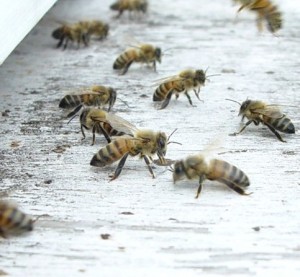21
Jan
Minnesota Takes Steps to Protect Bees, Beekeepers Demand Stronger Action
(Beyond Pesticides, January 21, 2013) Two Minnesota state agencies are creating plans they say will address declining pollinator populations in the state. The Minnesota Department of Natural Resources (DNR) is developing best management practices for managing and increasing pollinator habitat and the Minnesota Department of Agriculture (MDA) is developing a plan to study the impacts of neonicotinoid pesticides on pollinators. Critics of the state’s plan say that there is no more need to study the effects of neonicotinoids because the negative impacts they have on pollinators has been already studied extensively.
The DNR is developing guidelines to improve habitat for pollinator insects. Recent reports show that the planting of herbicide-resistant genetically engineered (GE) crops is responsible for habitat loss and the decline of native pollinators like the Monarch butterfly. The expansion of glyphosate tolerant GE corn and soybean cropland has allowed farmers to kill milkweed, the primary source of food for Monarchs, which historically grew between crop rows in the Midwest. A rapid expansion of farmland ””more than 25 million new acres in the U.S. since 2007”” has also eaten away grasslands and conservation reserves that supplied the Monarchs with milkweed. DNR officials have indicated this guide could change where grassland is burned or mowed, or add more plants as habitats for pollinators. DNR may also work in the future with the Minnesota Department of Transportation (MnDOT) to incorporate native wildflowers into roadside right-of-ways to increase pollinator habitat.
The MDA also gave the Legislature a report on Wednesday outlining, among other issues, a plan to study the use of neonicotinoids and their impacts on pollinators. The report was developed in response to the 2013 Pollinator Legislation H.F. 976. The specific risk neonicotinoids pose to pollinators will be the focus of the review, and will include a summary of research into neonicotinoid hazards to a variety of pollinator species in crop production and garden/landscape settings, and the related risks of biodiversity maintenance and ecological balance in natural ecosystems. The review will also include an overview of the effects residue accumulation in pollen, nectar, guttation droplets, and other pollinator exposure pathways associated with treated plants. According to MDA, special chemical reviews can take six months or more. Though it is important for states to take action to study these chemicals beyond the flawed Environmental Protection Agency (EPA) registration process, extensive scientific research has already assessed the hazards that these chemicals pose to pollinator species.
Steve Ellis, owner of Old Mill Honey Co. in Minnesota, expressed his frustration in a Public New Service article, saying, “We’ve already got 150 scientific papers that implicate the neonicitinoids in the bee decline. I’m not really sure we need more than that. It’s time in the United States that we took action, and I would hope that the Minnesota Department of Agriculture would step up to the plate and become proactive.”
Neonicotinoids are a relatively new class of insecticides that share a common mode of action that affect the central nervous system of insects, resulting in paralysis and death. They include imidacloprid, acetamiprid, clothianidin, dinotefuran, nithiazine, thiacloprid and thiamethoxam. Currently, neonicotinoid insecticides are the most widely used class of insecticides in the world and compromise about 25% of the global agrichemical market.
Neonicotinoids are systemic, meaning that as the plant grows the pesticide becomes incorporated into the plant. When honey bees and other pollinators forage and collect pollen or nectar, or drink from what are termed “guttation” (water) droplets emitted from neonicotinoid-incorporated crops, they are exposed to sublethal doses of the chemical. At this level, the pesticides don’t kill bees outright. Instead, they impair bees’ ability to learn, to find their way back to the hive, to collect food, to produce new queens, and to mount an effective immune response.
Beyond Pesticides through its BEE Protective campaign works with national and local groups to protect honey bees and other pollinators from pesticides and contaminated landscapes. As part of this campaign, Recently, Beyond Pesticides, as part of coalition, launched a national advertising campaign to raise awareness of pollinator declines and urge EPA to stop stalling by enacting substantive restrictions on the use of bee-harming pesticides. To support our efforts to restrict bee-toxic pesticides, visit save-bees.org and sign the petition to EPA Administrator Gina McCarthy.
Source: CrookstonTimes
All unattributed positions and opinions in this piece are those of Beyond Pesticides.












The myth that banning neonicotinoid pesticides will solve the Honeybee problem. Will banning the most toxic pesticide group help Honeybees, possibly. The even bigger issue of a lack of information & knowledge of the average person. The truth is most anything will kill a bee, Synthetic, Organic or otherwise can be toxic. The real problem is people do not read the labels other than how much to use (hopefully that much). Most every product that is toxic to Bees has specific instruction on how to use the product without harming them. Will it prevent all issues maybe not but far better than what we are doing now. Habitat loss is another big problem for Bees that we are not doing enough about & we all can. Don’t make your landscape a total dead zone with grass & mulch. Education, Education, Education! The imported European Honeybee decline is very likely a many faceted problem there is no one quick fix. Even Beekeepers will tell you that more research is needed.
January 22nd, 2014 at 2:49 pm